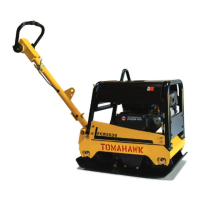12
3.5 Application
This plate is designed for compacting patchwork on asphalt, cohesive soils, granular soils,
sticky soils (clay or slit), gravel, sand, or mixed soils. It is designed to specifically maeuver
narrow, cramped spaces, the TPC100H compacts cohesive and granualr soils up to 15
inches, while its self-cleaning, open base plate minimizes rock and dirt build up.
3.6 Operation
3.6.1 Run engine at full throttle and allow plate to pull itself along at its normal speed. When
operating on an incline it may be necessary to assist plate by pushing it forward slightly.
Depending on the material being compacted, three or four passes are recommended to
achieve the best compaction.
While a certain amount of moisture in the soil is necessary, excessive moisture may cause
soil particles to stick together and prevent good compaction. If soil is extremely wet, allow it
to dry somewhat before compacting.
3.6.2 If soil is so dry as to create dust clouds while operating plate, some moisture should be
added to the ground material to improve compaction. This will also reduce service to the air
filter.
When using the plate on paving stones, attach a pad to the bottom of the plate to prevent
chipping or grinding surface of the stones. A special polyurethane pad designed for this
purpose is available as an optional accessory.
4. MAINTENANCE
4.1 Cleaning the Plate
Clean the plate aer use to remove dirt, stones, and mud caught under the engine console.
If plate is being used in a dusty area, check engine cylinder cooling fins for heavy dirt
accumulation. Keep engine cylinder fins clean to prevent engine from overheating.
CAUTION
DO NOT operate plate on concrete or on extremely hard, dry, compacted
surfaces. The plate will jump rather than vibrate and could damage both
plate and engine.

